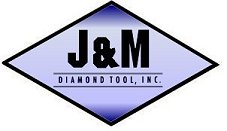| Composition of PCD (Polycrystalline Diamond) |
| Polycrystalline Diamond (PCD) is a synthetic diamond product that
is produced by sintering together selected diamond particles with a metal
matrix using sophisticated technology. The diamond and matrix, when sintered
together under high temperatures and pressures, creates a PCD tool blank
that is high in uniform hardness and is abrasive resistant in all directions.
This PCD diamond layer is then bonded to a tungsten carbide substrate,
which provides strength and a brazable base to permit bonding to other
metals. |
| Polycrystalline tipped tools are exceptionally resistant to wear
compared to tungsten carbide or ceramic tools. In certain applications,
PCD tool life can exceed carbide cutting tool life 50 to 100 times. |
| In certain applications, polycrystalline tipped tools have several
advantages over natural diamond. |
| |
 Shock
Resistance Shock
Resistance |
| PCD is more shock resistant over natural diamond because of its
random orientation structure of the diamond particles, and is backed by
a carbide substrate. |
| |
 Consistency Consistency |
| PCD is more constant in wear. Again because of the random orientation
of diamond particles. Natural diamond is a single crystal in nature and
has soft and hard grains. Depending on the shape of the natural diamonds
and the tool being manufactured, it is sometimes not practical to have
the hardest grain on the cutting edge. |
| |
 Availability Availability |
| PCD is readily available in a large variety of shapes and sizes.
Discs as large as 60 mm in diameter are now available. Natural diamond
is limited to what is formed in nature. Diamond, even with only an 8 mm
long cutting edge is extremely difficult to find and is very costly. |
| |
 Flexibility Flexibility |
| PCD is a conductor. This allows us to routinely produce complex
form tools and grooving tools with our wire EDM machines. Such tools are
impossible to produce in natural diamond. |
| |
 Cost Cost |
| PCD blank costs are considerably lower than the cost of natural
diamond stones, and the availability of different shape PCD blanks reduce
manufacturing cost significantly. The longer of a cutting edge required,
the larger the savings of PCD over natural diamond due to the rarity of
larger stones. |
| Natural diamond and PCD diamond compliment each other. Natural diamond
is denser than its PCD counterpart and consequently can be polished to
a keener cutting edge. |
| Natural diamond is best suited to produce very fine finishes and
precise tolerances as required in the manufacturing of jewelry, plastic
contact lens, computer memory discs, and aluminum camera parts. See natural
diamond tools. |
| Polycrystalline diamond tooling can be used in a wide range of machining
operations such as milling, grooving, turning, facing and boring. They
are recommended for machining nonferrous metals and abrasive non metallics. |

